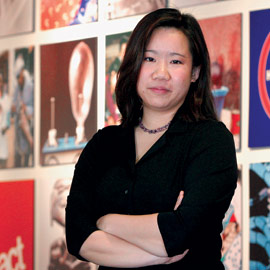Jiangxi, China: Improving Women's Health
  Though PATH employee Lisa Moy’s office is located just a few miles from SPU, her work is focused on the women of developing countries, where access to quality medical care is often limited. Though PATH employee Lisa Moy’s office is located just a few miles from SPU, her work is focused on the women of developing countries, where access to quality medical care is often limited.
|
 |
Chen, a 28-year-old Chinese mother of three, boarded the bus and carefully counted out the 2 yuan for the fare — trying not
to think of the food she could buy for her family with that money. She sat down and began the long ride home from the county
hospital to her village. How would she tell her family that she
had a serious woman’s sickness? The doctor said she needed a
very expensive surgery. Even if she sold her wedding jewelry and borrowed money from her elder brother, her husband wouldn’t
be able to afford the medical expenses. Maybe one of her younger brothers could travel to the city and get a job? And even if they found the money, how would her husband bring in the harvest
by himself? How would they ever repay their debt?
A world away in Seattle, my work revolves around helping women like Chen — more than 470,000 in developing countries across the globe — receive the critical health care they need.
I am an employee of The Program for Appropriate Technology
in Health (PATH), a nonprofit organization whose mission is
to improve the health of people around the world by advancing technologies, strengthening systems, and encouraging healthy behaviors. At PATH, I work to reduce suffering and save lives through the development of cervical cancer screening tests appropriate
for developing countries.
Despite the fact that cervical cancer is a preventable and treatable
disease, nearly 200,000 women across the world die each year due to lack of early detection, limited access to medical professionals,
and fear. When I think of the husbands, children, sisters, and brothers who are affected by the illness or loss of their loved ones, these statistics break my heart.
Our current methods to screen cervical cell abnormalities require an expensive manufactured test, trained health care workers
and laboratory technicians, a well-equipped laboratory, and multiple rounds of testing in a woman’s lifetime. The health care systems of developing nations do not have the number of trained personnel, facilities, and financial resources to implement modern cervical cancer screening tests. As a result, hundreds of thousands of women go unscreened; cervical cell abnormalities are left untreated; and more fall victim to cancer.
To make these screenings possible, our scientists and collaborating
partners are designing low-cost, easy-to-use tests with little
or no specialized diagnostic equipment. The mainstay of my work is to ensure that each test is culturally appropriate for the women of each country. Because this requires research and programs
that link the needs of women with government policymakers,
hospital procurement officers, existing medical factories in China, and other key stakeholders, it is no easy task.
With an internal grant at PATH, I recently traveled to China’s Jiangxi province to collect data on China’s health care facilities at the village, township, county, and provincial levels and provide logistical support for a rural cervical cancer screening campaign supported by PATH. I also had the opportunity to talk with rural women and local health care workers to learn how they utilize
the existing health care system and hear their needs.
In a crowded hallway, with two interpreters on hand (English to Mandarin and then Mandarin to the local dialect), the women told me that leaving for the big-city hospital meant asking their mothers-in-law to care for their children and manage their household duties. Most had never been to see a doctor at a hospital,
because it takes an entire day’s travel to reach the medical facility by bus, with a necessary return visit to learn test results. Their stories confirmed that regular visits to a health care provider
for preventative medical care aren’t realistic for women in rural areas of Jiangxi. From these qualitative glimpses into a Chinese
village-woman’s life and gathered quantitative data, our team confirmed that an ideal cervical cancer screening test would produce
quick results, providing answers within the same visit.
My conversations with Jiangxi women were not dry fact-finding interviews, but filled with smiles, lots of hand motions to compensate for the lack of common language, and a real desire for a shared understanding. I feel honored that they took the time to speak to me, allowing a glimpse into their lives. While some of their stories are filled with hardship and tragedy, they are also characterized by perseverance and strength, which inspires me.
I think that one aspect of global engagement is bowing to our powerlessness to solve the world’s pervasive problems and acknowledging God’s sovereignty. The problems of our world are tragic; the obstacles are never-ending; and the solutions are imperfect. We must embrace our responsibility to be God’s hands and heart to his people. As Christ took on my sufferings, and made them his own — so should I, so should we, take on the burdens of others.
Brikama, The Gambia: Trading Comfort for Commitment
Port-au-Prince, Haiti: When God Says "Go"
— BY LISA MOY '00
Back to the top
Back to Home |
